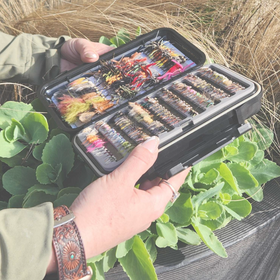Tarpon or "Silver Kings", if you want to see someone's face light up, talk to a fly fisher who has caught one of these treasures of the sea. For the average trout fly fisherman, however, the word Tarpon means some obscure saltwater species. Pursued in exotic places, generally out of budget, out of reach and out of the question. Yes, when most of the time people talk Tarpon they are talking exotic locations like Costa Rica, Belize, Nicaragua, and Mexico. Although, Florida perhaps is best known for it's seasonal Tarpon. But there are other locations that are affordable and easier for most of us to get to. Texas, South Carolina, and Georgia all have Tarpon fly fishing, complete with guides, maps, and they ready to serve you
So what exactly is a tarpon, besides a pre-historic fish with metal jaws? To those that call the Tarpon their favorite prey, it is well earned. The Tarpon, nicknamed Silver Kings, are legendary for their jumps and runs that test even the most experienced angler. Spitting out hooks, tangling lines, and breaking off are skills that seem second nature to this most challenging of fish. One guide says if they land one in ten they are doing good for the day. Tarpon generally average 50 pounds and around 50 inches. But they can get down right huge, just surf the internet for Tarpon pics, and be prepared to be in awe. Size can vary by locality, Florida being known for larger than average fish. Tarpon are silvery colored and in the water they take on a larger than life appearance shimmering like gray ghosts, for the first timer, spotting one of these is literally breath taking. Heartbeats race, as they take on a mythical quality for the uninitiated. Tarpon also are similar to the Steelhead in which they inhabit rivers as well as saltwater, the Rio Grande in Central America is best known of these rivers, Tarpon call their home away from home. The Tarpon actually have the ability to breath air, which allows them to live in the fresh water and air stagnant waters. This same characteristic is a gift to fly fishers, searching for the infamous 'rolling' that makes spotting them easier.
Which brings us to my favorite aspect of fly fishing for Tarpon. Sight fishing. Tarpon are generally found in very shallow water, as they are sensitive to cold water. Fly fishing for Tarpon is simply put fly fishing for a giant skittish fish in its natural habitat, with crystal clear water, all the advantages are the fish's. Not recommended for beginners this wily fish has frustrated many a veteran fly fisher as well. Many of the problems stem from the fact that the fly fisher more often than not became schooled in the art of fly fishing while pursuing the trout.
Besides the obvious differences of size and habitat there are subtler differences as well. For one, the mouths, tarpon mouths are like a steel vise, there will be no ripping the mouths of these creatures. Setting of the hook in the Tarpon's mouth is an entirely different event than that of a trout. The gear used will be heavier 11-12 wt rods are common in Florida, also the casts are longer. Knowing how to double haul is required, and this takes practice, your backyard or driveway are as good as places as any.
Sight fishing isn't unknown to most trout fly fishers. Indeed it is probably the easiest adaptation, and the reason Tarpon are so popular with fly fishers. However, 100 foot casts and the crystal clear waters Tarpon are found, lend to a whole new experience, one that requires some patience and getting used to. Also due to the amount of line involved, as well as the amount of line taken out on a nice run. Tangling becomes a probability like no other time since your early days, when you were crying out "Dad" every five minutes.
Like many salt water species, location plays a big part in selecting the fly fishing flies. At Big Y Fly Co., we stock some of the most well known Tarpon flies on the planet including the Tarpon Cockroach, Tarpon Red/White, and Tarpon Orange/Black. As well as Tarpon bunnies.
Which brings us to my favorite aspect of fly fishing for Tarpon. Sight fishing. Tarpon are generally found in very shallow water, as they are sensitive to cold water. Fly fishing for Tarpon is simply put fly fishing for a giant skittish fish in its natural habitat, with crystal clear water, all the advantages are the fish's. Not recommended for beginners this wily fish has frustrated many a veteran fly fisher as well. Many of the problems stem from the fact that the fly fisher more often than not became schooled in the art of fly fishing while pursuing the trout.
Besides the obvious differences of size and habitat there are subtler differences as well. For one, the mouths, tarpon mouths are like a steel vise, there will be no ripping the mouths of these creatures. Setting of the hook in the Tarpon's mouth is an entirely different event than that of a trout. The gear used will be heavier 11-12 wt rods are common in Florida, also the casts are longer. Knowing how to double haul is required, and this takes practice, your backyard or driveway are as good as places as any.
Sight fishing isn't unknown to most trout fly fishers. Indeed it is probably the easiest adaptation, and the reason Tarpon are so popular with fly fishers. However, 100 foot casts and the crystal clear waters Tarpon are found, lend to a whole new experience, one that requires some patience and getting used to. Also due to the amount of line involved, as well as the amount of line taken out on a nice run. Tangling becomes a probability like no other time since your early days, when you were crying out "Dad" every five minutes.
Like many salt water species, location plays a big part in selecting the fly fishing flies. At Big Y Fly Co., we stock some of the most well known Tarpon flies on the planet including the Tarpon Cockroach, Tarpon Red/White, and Tarpon Orange/Black. As well as Tarpon bunnies.




